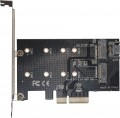Interface
An interface that connects a PCI controller to a motherboard.
— PCI-E (PCI Express). An interface that is actually a modern standard for motherboards and peripherals connected to them, including PCI controllers. It is the heir to PCI-E, noticeably surpasses it both in terms of data transfer speed and additional functionality. Note that "motherboards" and peripherals for them can use a different number of PCI-E lines — for controllers, in particular, options
1x,
2x,
4x and
8x are relevant. At the same time, the first three values are found among expansion cards, but 8 PCI-E lanes are used mainly in RAID controllers (see "Type"). Also note that more lines means not only higher speed, but also a larger connector size. As a result, a board with a smaller number of lines can be connected to a slot with numerous channels (for example, a 1x board in a 4x connector), but not vice versa. As for bandwidth, it depends on the PCI-E version and is slightly less than 1 GB / s per line for PCI-E 3.0 and slightly less than 2 GB / s per line for PCI-E 4.0.
— PCI. Due to the advent of the more advanced PCI-E standard, this interface is now considered obsolete. However, it provides data transfer rates up to 533 Mbps, which is quite enough for tasks that do not involve the need to quickly transfer large amounts of information. Another
...advantage is that when connected to such a connector, faster PCI-E slots remain free, which can be useful for other system components. As a result, PCI connectors are still used in modern motherboards, and controllers with such a connection can also be found on the market.SATA 3
The number of
SATA 3 connectors provided on the controller board.
Initially, the SATA standard was developed for connecting internal drives, primarily hard drives (HDDs). And SATA 3 is the most modern and fastest version of this interface: it provides data transfer rates up to 600 MB / s (4.8 Gbps). For hard drives, this is quite enough, but for faster SSD modules, this is not enough. So although PCI controllers with such an interface can still be found on the market, there are very few of them. The number of SATA 3 connectors depends on the type of controller (see above): in expansion cards there can be only one such port, but in RAID modules there are at least 2, and more often 4.
mSATA
The number of
mSATA connectors provided on the controller board.
mSATA is a smaller version of the SATA connector that differs from the full-size version only in shape and size. Recall that SATA in different versions is used to connect hard drives, as well as individual models of SSD drives (usually low-cost ones that do not differ in speed). In PCI controllers, for a number of reasons, such an interface has not been widely used; therefore, mSATA is extremely rare — in single RAID modules (see "Type"), designed for miniature form factors.
Note that mSATA connectors are very similar to mini PCI-E slots, but these interfaces are not compatible.

